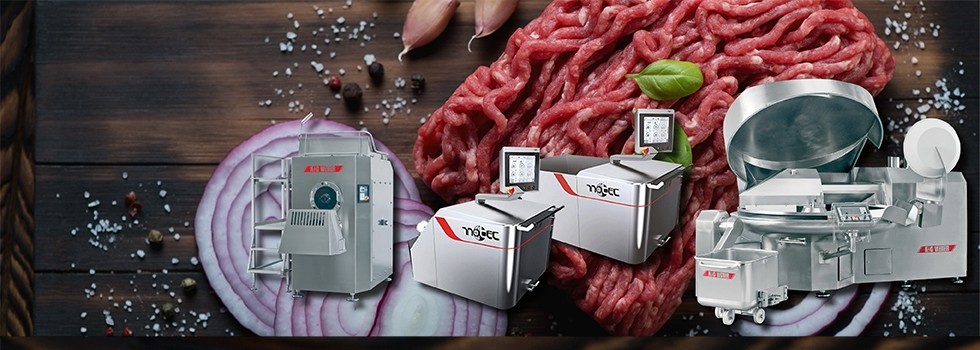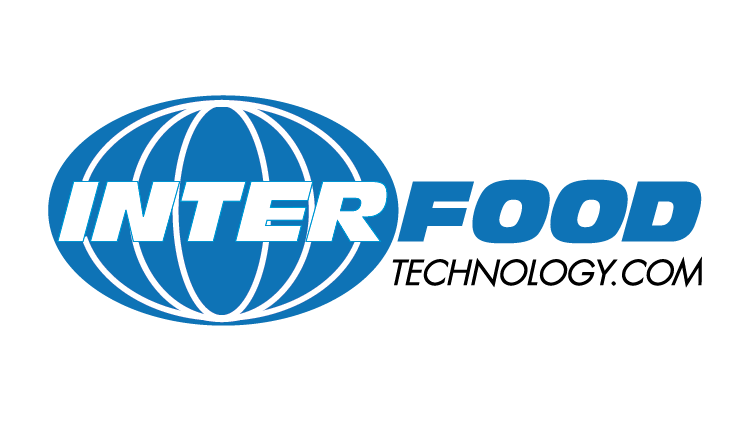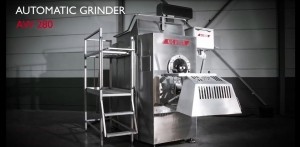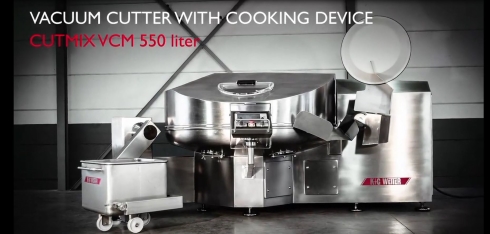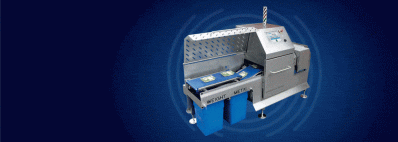Promotional Features
It’s all in the Prep
Ensuring a quality product is often about getting the basics right and, when it comes to ‘Preparation’, this is undoubtedly the case. As Preparation is the particle reduction element of the food processing operation – mixing, grinding, bowl chopping, emulsification and dicing & shredding – consistency at this stage can make a considerable contribution to a successful end-result.
Mixing/Grinding
A significant proportion of meat supplied for processing in the UK arrives as frozen blocks, often imported and, typically, provided in 600mm x 400mm x 200mm sizes. One of the first operations in preparing the meat is to grind them down, using a frozen block grinder to reduce them to the requisite size (a 10mm particle size is not an atypical goal). Grinding straight from frozen removes the need to place the blocks on racks for tempering, which can be space- and time-consuming as blocks usually start with a meat temperature of around -18°C. The friction involved in the grinding process generates heat, potentially 5°C to 6°C for a 10mm final particle size.
The frozen meat is then transferred to another grinding or mixing stage, which again adds heat. Given that you want to be mixing at temperatures below 4°C, using frozen meat as part of the mix is common practice. At this point, fresh meat is often added, along with any spice and the elements are blended together.
An alternative approach is to combine the two processes by using a mixer/grinder. These machines tend to be used in small to medium-sized processing operations, offering a reduced footprint and enabling the user to add spices earlier. Larger operations, meanwhile, tend to use a series of machines, with grinders feeding into mixers via hoppers, screw or belt conveyors and tippers. Choosing which option best fits the need is really about considering the application and the throughput required. For more details, click on link here.
Bowl chopping
While bowl choppers do a very similar job to mixer/grinders, they are still used extensively in the Preparation process, with production carried out in batches. Bowl chopping is often used to manufacture sausages, particularly cooked sausage, for which a grinder is not really suitable. Bowl choppers are also an excellent option for cutting down the gripper ends from slicing applications: for example, the end of a cooked ham that has been gripped and has therefore not passed through the slicing blade can be chopped into smaller particles for use in, say, pizza production – an operation that would not be possible with a mixer. For more details, click on link here.
Emulsification
Moving beyond grinding, chopping and mixing is emulsification, used extensively in the preparation of baby food and food served in hospitals, along with sausages and burgers, which are staple products for Preparation equipment. An emulsifier features a series of plates – say five – with the product passing through each plate in a single pass to gradually reduce in size from 10mm to 8mm and all the way down to 1mm. This is used when very fine particles are required in a product and, as in mixing and grinding, the friction involved generates heat, so it is important to monitor the temperature.
Dicing & Shredding
The other area of particle reduction – taking large source material and reducing it in size to allow it to be used in other products – is dicing & shredding. Versatility is one of the key factors to consider when purchasing this equipment, as it needs to accommodate a range of different meats (sometimes requiring bone-in and boneless operation) and have wide-ranging capacities. This versatility needs to extend into different loading options: hand loading, tote bin or even full conveyor automation depending on requirements. In producing cubes and strips, it is important to generate consistently clean, uniform, sinew-free edges.
Diced products are often bagged to be sold on to foodservice operations or for further processing
Consistency across equipment and operator
As already mentioned, achieving a good product relies on the consistency of water, ingredients, process and – sometimes overlooked – the consistency of operator. Given that many food processing businesses are subject to high staff turnover, ensuring the same person is operating a machine for any length of time is sometimes difficult. This is why training, and re-training, is important. The increasing use of touchscreen technology has helped to improve this process, enabling recipe formulations to be stored and easily retrieved, but it is dangerous to assume that an inexperienced operator will simply be able to ‘pick it up’. A consistently good product is about taking out, or at least minimising, the variables.
The fat factor
Fat analysis, particularly in products such as mince, sausage and beef burgers, is important. Anybody involved in the food industry is acutely aware of the increased focus on healthier eating. Cattle are being bred to be leaner, meaning that trims and cuts typically used in beef burgers can be too lean for a product that relies heavily on the correct fat levels. Being able to monitor and automatically adjust fat levels can therefore be an invaluable asset in burger production. Likewise with mince, consumers are increasingly focusing on the health information included on packaging labels, and it is commonplace to see fat content levels of 5%,10% etc stated for minced products.
Development of non-meat opportunities
Continuing the theme of customer trends, vegetarianism and veganism have a higher profile than ever before. Though some 90% of the equipment supplied by Interfood is used in the production of meat products, the development of meat-free products presents a growing opportunity – not only from companies dedicated solely to the production of vegetarian/vegan foods but also from traditional meat producers who are recognising the potential for developing their own ranges to include meat-free options.
Much of the equipment already described can be used in the production of vegetarian foods, but there are also specialist machines within Preparation that offer particularly significant opportunities in this sector. For example, power heater systems are now available, which produce vegetarian, vegan and hybrid products that achieve the all-important bite and mouthfeel the industry is looking for in such products, often without the use of egg albumen.
Meeting the regulations
Preparation equipment, as with any machinery used in food processing in the UK, needs to comply with a whole host of stringent health and safety standards. According to the most recent statistics published by the HSE (Health & Safety Executive), in the food and drink industry, machinery and plant cause over 30% of fatal injuries, over 10% of major injuries (those requiring hospitalisation), with almost 500 injuries a year reportable to the HSE[1].
The importance of regulations and standards is therefore clear, with PUWER (Provision and Use of Work Equipment Regulations) being a central requirement in the food machinery arena. PUWER can be quite ambiguous so it is important to choose a machinery supplier with experience and expertise in how to make any necessary modifications, such as adding guarding, locks and safety switches, to meet the requirements. At Interfood, we place great emphasis on PDI (pre-delivery inspection), or FAT (factory acceptance test) visits. The best option is to undertake these at the equipment manufacturer’s site so that any fabrication can be carried out there rather than in a food processing environment.
Making the right decision
In conclusion, the importance of the quality of manufacture of Preparation equipment cannot be over-emphasised. Grinders, mixers, bowl choppers and emulsifiers are the workhorses of food processing. They get through a lot of work, so need to be durable to meet these demands. Any food processor should consider a number of basic questions when investing in the equipment: identifying the volumes required (tonnage per day, kg per hour); calculating what the temperature of the product will be when entering and exiting the machine; ensuring the equipment is easy to clean and maintain; and, of course, what type of product is being processed.
Given the wide range of products being manufactured and even the small nuances between very similar products, trials can be crucial in making the right investment decision. At Interfood, wherever possible, we look to hold product trials at a customer’s site but also have test facilities at the equipment manufacturers’ premises if required.
Automation is increasing and while not all processes can be automated – the holy grail of a machine to take over the labour-intensive manual production of pigs in blankets remains elusive, for example – reliable machinery that produces consistent results is an invaluable contributor to any food processing operation.
[1] Source – hse.gov.uk/foodmachinery
